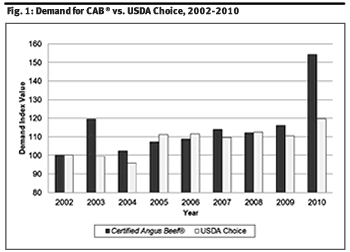Demand for the Brand is
Good News for Angus Producers
Beef is the protein of choice for celebrations, but most people know how little there was to celebrate with respect to beef demand in the 1980s and early 1990s.
Demand was down, but spirits were not, at least not among those who worked for the Certified Angus Beef® (CAB®) brand. Founded at the start of that downward spiral, the brand was just hitting its stride as overall demand finally began to recover in the last years of the 20th century and into this millennium.
Of course, basic economic lingo reminds us it's not only about demand. Does the phrase "supply and demand" ring a bell?
"Consumers want more high-quality beef. If you produce it, the market will reward you for it."At first, supply was CAB's biggest limitation. Then, as new packers and processors came on board that problem seemed resolved — until cattle hit a record low acceptance rate of 14%. That was just five years ago, but the supply situation and grading trends have improved dramatically since then.
Throw in factors like population growth and inflation, and it gets awfully hard to tell if the increased prices paid for CAB brand products, coupled with several consecutive, record-setting sales years, really amounts to an increase in demand.
Supportive data
Research out of Kansas State University (K-State) illuminates the subject. Economist Ted Schroeder and master's student Lance Zimmerman created a demand index to help compare year-to-year data and its impact on demand.
The methodology and results are explained in their research paper, "Defining and Quantifying Certified Angus Beef® Brand Consumer Demand."
When comparing the CAB index to one Schroeder's team helped build for USDA Choice beef a decade ago, we feel more confident that the CAB sales volume figures and prices tell the story. Taking everything else into account, the CAB data translates into solid economic facts.
"The demand for CAB has outpaced Choice product since 2002," the paper says. "Demand for CAB increased 56% over the eight years and Choice demand increased 20%."
 In both cases, the biggest increase was from 2009 to 2010 (see Fig. 1), which highlights another familiar story. The recent economic recession hurt the foodservice business, but recovery helped spur wholesale beef sales. So it's not surprising to find the best year-over-year performance there, particularly since these tools best represent demand at the retail level, which led the way in beef sales recovery.
In both cases, the biggest increase was from 2009 to 2010 (see Fig. 1), which highlights another familiar story. The recent economic recession hurt the foodservice business, but recovery helped spur wholesale beef sales. So it's not surprising to find the best year-over-year performance there, particularly since these tools best represent demand at the retail level, which led the way in beef sales recovery.
The year 2010 marked the highest CAB demand index on record at 154.
"The brand increased sales by more than 100 million pounds (lb.) compared to 2009, and the brand's cutout value increased more than $5 per pound in deflated U.S. dollars," the paper states. "There was not another year in the model where both per capita consumption and real cutout prices increased relative to the previous year."
We saw another positive beacon in the research: The index showed that strong international sales years (2003 and 2010) were also the two highest years for wholesale brand demand.
Growth in international sales remains strong, on track to break the 2003 record this year as it claims more than 10% of the brand's total sales.
CAB has own demand line
Demand for USDA Choice beef and demand for CAB products are closely related, but certainly not identical.
"The commodity product seemed to be more dramatically affected by negative macroeconomic factors, such as trade barriers and overall economic health," the research states. "It is also worth noting that demand for Choice product appears slower to rebound during times of recovery than CAB demand."
Oftentimes all "high-quality beef" is lumped together as Choice and higher. This economic analysis and model represent the first scholarly work to note that Choice vs. CAB is not a direct comparison because factors like brand loyalty and consumer preference enter the picture.
For those who are already using Angus genetics and aiming for higher brand acceptance, this research is extremely positive. Still, it can be hard to make a direct connection between farm-level prices and retail beef price stickers. Earlier research from Montana State University looked at that very correlation, which provides excellent context today.
Economist John Marsh looked back on total U.S. beef demand from 1976 to 1999 and noted a 66% decline. That translated to a 40% reduction in fed-cattle prices, and feeder-calf prices dropped 48% during that period.
The recent K-State research says, "Improving demand at the consumer and wholesale level can have an equally dramatic, positive influence on farm-level prices and production, and these effects can be illustrated by the success of CAB and the Angus breed."
That's backed by such numbers as CAB premiums in the $5-per-hundredweight (cwt.) range, video sale Angus breed premiums of $6.55 and 63% Angus-influence in the 2010 U.S. steer and heifer slaughter.
We have been saying it for a long time: "Consumers want more high-quality beef. If you produce it, the market will reward you for it."
Even in this period of relatively higher quality grades, we have confidence in our sales team, our marketing efforts and, most importantly, our licensed partners. Aim high, produce the best beef and they will market it to a world that is hungry for consistent quality. Having more CAB product in the supply chain will increase rather than diminish its relevance to the industry.
When looking at this demand index, we're even more convinced. Check out the entire white paper at
www.cabpartners.com/news/research/index.php.














